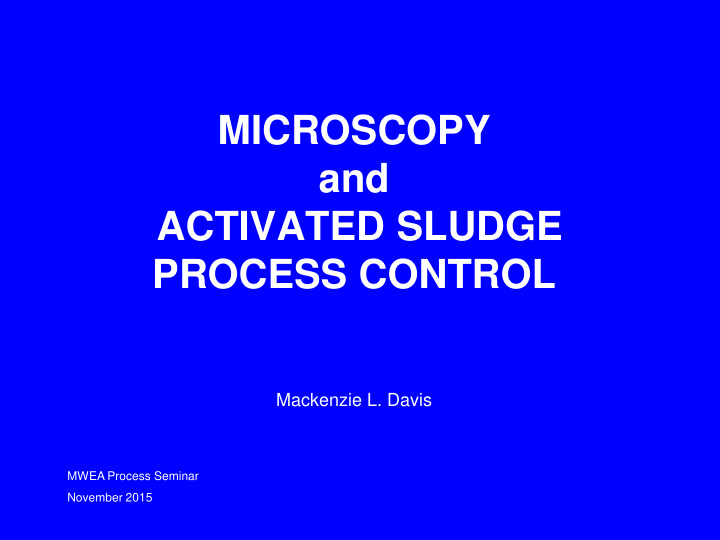



MICROSCOPY and ACTIVATED SLUDGE PROCESS CONTROL Mackenzie L. Davis MWEA Process Seminar November 2015
CREDITS
Activated Sludge Microscopy – Notes & Thoughts • The ultimate objective of activated sludge microscopy is to identify potential filamentous bacterial causes of solids separation performance problems. • Microscopy is only one tool. • The objective of this talk is to make you aware of some of the typical microbial culprits that may be diagnosed with a microscope AND other operational data.
Activated Sludge Microscopy – Notes & Thoughts • This lecture will not explain the mechanics of microscope operation or staining techniques… Refer to WEF text on microscopy. • This lecture WILL NOT make you an expert in activated sludge microscopy!!
FOCUS BULKING & FOAMING SLUDGE
Aeration tank in service. Faded “orange” pipes are air headers.
“Soap” bubbles Effluent from primary settling tank RAS Influent to activated sludge aeration tank from primary settling tank and return activated sludge (RAS) from secondary settling tank. This photo was taken in the 1970s before restrictions were placed on using phosphorus builders in detergents.
Scum baffle Oxidation ditch scum baffle and effluent structure. Foam is accumulation of bubbles that have frozen (note white ice layer near scum baffle). When the air temperature rises above 0 o C the scum “melts” and dissipates.
Aeration tank in service. Start up problems with Nocardia foam.
FACTORS AFFECTING SLUDGE BULKING • Design Limitations • Wastewater Characteristics • Operational Issues
DESIGN LIMITATIONS • Poor Mixing • Clarifier Design • Limited Return Sludge Capacity • Process Loading • Internal Plant Overloading • Limited air supply
Microscopy CANNOT Help Identify These Problems
WASTEWATER CHARACTERISTICS • Flowrate Variations • Composition/characteristics • Industrial waste component/composition • Animal and vegetable FOG • Sulfur compounds • pH • Temperature • Nutrients
Microscopy CAN Help Identify Composition/Characteristics Problems
OPERATIONAL ISSUES • MCRT • Low F/M • Low Dissolved Oxygen • Nutrient Deficiency (nitrogen and phosphorus)
Microscopy CAN Help Identify These Issues
Causes of Bulking Sludge and Likely Suspects
MCRT VS F/M MCRT vs F/M 35 30 25 MCRT, d 20 15 10 5 0 0 0.1 0.2 0.3 0.4 0.5 0.6 0.7 0.8 0.9 F/M kg BOD/kg MLSS-d
MOST UNWANTED FOR BULKING AND/OR FOAMING
Nocardioform Organisms Nocardioform organisms include: Gordonia amarae , Microthix parvicella and the Following pathogens: N. caviae, N brasiliensis , N. asteroides , and strains of Mycobacterium and N. farcinica
MUG SHOTS OF TOP TEN MOST UNWANTED FOR BULKING AND/OR FOAMING
Gram Stain • Positive (+) => purple • Negative (-) => pink
No. 1: Nocardia
No. 2: Type 1701
No.3: Type 021N
No.4: Type 0041
No.5: Thiothrix Note: “Thio” = sulfur; sulfur granules are characteristic
No.6: Sphaerotilus natans
No.7: Microthrix parvicella
No. 8: Type 0092
No.9: Haliscomenobacter hydrosis
No.10 Type 0675
Use the “Dichotomous Key for Identification of Filamentous Organisms”
Gram Stain • Positive (+) => purple • Negative (-) => pink
Neisser stain • Positive (+) = bluish color • Negative (-) = brownish color
Sulfur granules Gram positive Gram negative Neisser positive Neisser negative Source: Jenkins
Way Past Time to Take Corrective Action!!!
Run for the Hills Foaming is Out of Control!!!
OUT TAKES
MICROSCOPY METHODOLOGY
Sampling point • Good mixing – end of aeration basin or mixed liquor channel between aeration basin and secondary settling clarifier Take mixed liquor samples from below surface to exclude foam
Sampling point • Sample foam from one of following points • (1) Surface of effluent end of aeration basin • (2) Surface of mixed liquor channel • (3) Surface of secondary clarifier
Sampling Frequency • (1) Routine on site examination • About once every MCRT • (2) Routine off-site laboratory • Weekly to monthly • (3) Daily for critical periods • (a) When bulking occurs • (b) During RAS chlorination for bulking control
Sample Transport and Storage • (1) Examine as soon as possible after collection but not more than several hours • (2) For more lengthy periods store at 4 0 C • Low F/M; High MCRT – within 7-10 days • High F/M; Low MCRT – within 3 to 4 days • • (3) Transport in small plastic containers (not glass) • (4) Do not fill containers more than half full
Microscope • Use a research grade, phase contrast microscope with 10x and 100x (oil immersion) phase contrast objectives that yield magnifications of approximately 100x and 1000x respectively. Use phase contrast because biological materials have very low contrast when viewed with direct illumination. • COST = about $5,000
Recommend
More recommend